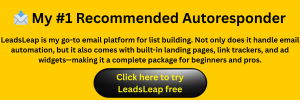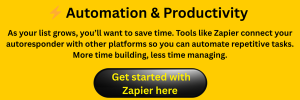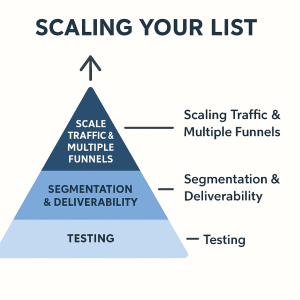Email List Building — The Complete Beginner-to-Pro Guide
Introduction: Why Email Is Still King
In the fast-moving world of online marketing, trends come and go. New social platforms rise, ad costs skyrocket, and algorithms constantly shift. But one marketing channel has stood the test of time: email marketing.
For every $1 spent on email, businesses see an average return of $36–$42. That’s one of the highest ROIs in digital marketing, and it’s why list building is often called the foundation of online success. Whether you’re an affiliate marketer, blogger, or small business owner, your email list is the single most valuable asset you own.
Think of it this way: your website traffic may come and go, your social followers could vanish overnight, but an email list is something you truly control. It’s a direct line to your audience, one that lets you build trust, deliver value, and make sales on demand.
This guide will walk you step-by-step through the process of building, growing, and profiting from your email list. By the end, you’ll understand not only how to get started, but also how to scale into advanced strategies that turn subscribers into loyal customers.
👉 Pro Tip: To help you take action as you read, grab my free checklist “10 Steps to Build Your First Email List”. It’s a simple PDF roadmap you can follow alongside this guide.
What Is Email List Building? (The Basics)
At its core, email list building is the process of collecting contact information—usually names and email addresses—from people interested in your niche. The goal isn’t just to add numbers to a database; it’s about building a community of subscribers who trust you enough to open your messages and eventually buy from you.
Here’s the simplest way to understand it:
-
Rented traffic: When you run Facebook ads, post on TikTok, or use traffic exchanges, you’re at the mercy of someone else’s platform. They control the rules, costs, and algorithms.
-
Owned traffic: When you have a list, you own the relationship. You can reach your subscribers anytime, without worrying about external changes.
This is why top marketers say, “The money is in the list.” It’s not about one-time clicks—it’s about building a long-term pipeline of potential customers.
Key terms to know (beginner’s glossary):
-
Opt-in: When someone gives permission to join your list (usually via a form).
-
Lead Magnet: The free gift or resource offered in exchange for an email.
-
Squeeze Page: A landing page designed to capture emails with minimal distractions.
-
Autoresponder: A tool that automatically sends emails on your behalf.
👉 By mastering these basics, you’ll have the foundation needed to start growing your list effectively.
Why You Need a List (Key Benefits)
If you’re serious about growing an online business, building an email list is non-negotiable. In fact, many marketers will tell you that if they had to start over from scratch, the first thing they’d do is build a list. Here’s why:
1. Direct Communication with Your Audience
When someone subscribes, they’re giving you permission to step into their inbox—a place they check daily. Unlike social media, where algorithms decide who sees your content, email lands right where your audience is already paying attention.
2. Trust and Relationship Building
Email allows you to go beyond one-off sales pitches. You can share tips, stories, and personal insights that help your subscribers see you as more than just another marketer. Over time, they start to trust your recommendations—which makes them far more likely to click, engage, and buy.
3. High ROI and Profit Potential
Email is still the most profitable marketing channel available. When you send a broadcast or an automated sequence, you’re reaching people who have already shown interest. That means every message has the potential to generate revenue—without paying for ads over and over again.
4. You Control the Platform
Social networks can shut down accounts, ad platforms can raise prices overnight, and search engines can change rankings. Your email list, however, belongs entirely to you. No one can take away your subscribers, and that gives you stability no matter what happens elsewhere.
5. Long-Term Leverage
A list isn’t just for one-time sales. As you grow, you can launch new products, promote affiliate offers, or even survey your subscribers to understand their needs better. It’s a long-term asset that compounds in value over time.
👉 Quick Exercise: Imagine being able to send an email tomorrow and instantly reach 1,000 people who know your name, trust your advice, and are waiting for your recommendations. That’s the power of list building.
The Core Elements of List Building
Before you start collecting subscribers, you need to understand the essential pieces that make list building work. Think of it like a simple machine: each part plays a role, and when they’re connected, the system runs smoothly.
Here are the four pillars every email list building strategy relies on:
1. The Lead Magnet
This is your free gift—the hook that convinces people to hand over their email address. Without something valuable in exchange, most visitors won’t bother signing up.
-
Examples: eBooks, checklists, cheat sheets, case studies, templates, or even access to a mini video course.
-
Rule of thumb: Your lead magnet should solve one specific problem quickly. Don’t overwhelm—make it short, actionable, and irresistible.
👉 Example: “10 Must-Know Safelist Marketing Tips” could be a perfect lead magnet for your site.
2. The Squeeze Page (Opt-In Page)
Once you have your lead magnet, you need a dedicated landing page to capture signups.
-
Keep it simple: one headline, one promise, one call-to-action.
-
Remove distractions like menus, sidebars, or extra links.
-
Include a visual (eBook mockup, checklist preview, or video thumbnail) to make it feel tangible.
👉 A squeeze page is where curiosity and clarity meet: “I understand what I’ll get, and I want it.”
3. The Autoresponder (Email Service)
After someone opts in, you’ll need a system to:
-
Store their contact information.
-
Deliver the lead magnet automatically.
-
Send a series of follow-up emails to build trust and promote offers.
Popular options: LeadsLeap, AWeber, GetResponse, ConvertKit.
👉 Pro Tip: Set up a welcome sequence (3–5 emails) before sending regular broadcasts. That way, every new subscriber immediately experiences value.
4. Traffic Sources (Fuel for Your Funnel)
Even the best lead magnet and squeeze page won’t work without traffic. You need a steady stream of visitors to test, optimize, and grow.
-
Free traffic: traffic exchanges, safelists, SEO content, social media, YouTube.
-
Paid traffic: solo ads, co-op traffic, Google/Facebook ads.
👉 Traffic is the lifeblood of your list. Without it, your funnel stays empty. With it, your email list becomes a powerful engine for growth.
Creating an Irresistible Lead Magnet
Your lead magnet is the front door to your email list. It’s the reason someone stops scrolling, clicks on your page, and decides to hand over their email address. If your lead magnet is weak, your list growth will stall. If it’s strong, your list can grow quickly—even with modest traffic.
So, how do you create a lead magnet that people can’t resist?
1. Solve One Specific Problem
The best lead magnets don’t try to cover everything—they provide a quick win. Think of your audience’s biggest pain points. What’s something you can help them solve in 10 minutes or less?
-
Example: “5 Email Subject Lines That Always Get Clicks” (for affiliates struggling with open rates).
-
Example: “Beginner’s Checklist for Safelist Marketing” (for newbies testing traffic exchanges).
👉 The key: Keep it focused and immediately useful.
2. Choose the Right Format
Different people prefer different formats, but the rule is: keep it simple. Long eBooks are often ignored, while short and actionable resources work best. Here are proven formats:
-
Checklists: Easy to consume and implement.
-
Cheat Sheets / Templates: Give subscribers a shortcut.
-
Mini eBooks (5–10 pages): Provide just enough depth without overwhelming.
-
Case Studies: Show real results they can learn from.
-
Video / Audio Lessons: Great for building a personal connection.
👉 For i-MarketingZone, checklists and cheat sheets are perfect starting points because they match the “fast-action” mindset of affiliate marketers.
3. Make It Visually Appealing
Presentation matters. A simple PDF works fine, but if you can make it look professional, it’ll instantly feel more valuable.
-
Add a clean cover design.
-
Use icons, bullet points, and clear formatting.
-
Include your website branding for consistency.
👉 Tools like Canva or Designrr make it easy to create polished PDFs, even if you’re not a designer.
4. Align It With Your Offers
Your lead magnet should naturally lead into the products or services you want to promote.
-
Example: If your lead magnet is “10 Safelist Marketing Tips,” your follow-up sequence could recommend LeadsLeap as a tool to track and optimize results.
-
Example: If your lead magnet is “Affiliate Funnel Checklist,” your emails could introduce autoresponders, landing page builders, and funnel software (with your affiliate links).
👉 Always ask: Does this lead magnet attract the right type of subscriber for my future offers?
5. Name It for Maximum Impact
The title of your lead magnet is almost as important as the content itself. A weak name gets ignored; a strong one gets clicks.
-
Use power words: Quick, Simple, Proven, Secret, Ultimate.
-
Highlight the benefit: “…That Gets You X Result in Y Time.”
-
Keep it short and clear.
Examples:
-
“The Affiliate Funnel Blueprint: 5 Steps to Your First Commission.”
-
“10 Must-Know Safelist Marketing Tips (Newbie Friendly).”
-
“Quick Start Checklist: Build Your Email List in 24 Hours.”
Crafting a High-Converting Opt-In Page
Your lead magnet may be amazing, but if your opt-in page (also called a squeeze page) doesn’t convert, it won’t matter. The opt-in page is where the magic happens—it’s where a casual visitor becomes a subscriber.
Here’s how to craft one that works:
1. Start With a Clear, Benefit-Driven Headline
Your headline is the first thing people see. It should answer the question: “What’s in it for me?”
-
Example: “Get 10 Proven Safelist Tips That Double Your Clicks in 7 Days or Less.”
-
Example: “The Simple Checklist to Build Your First Email List (Even If You’re Brand New).”
👉 Don’t overcomplicate—clarity beats cleverness every time.
2. Keep the Page Simple and Focused
The best squeeze pages have one goal: capture the email. That means:
-
No navigation menus.
-
No sidebars.
-
No external links (except privacy policy).
-
Just the offer and the form.
👉 Think of it as a digital billboard: one message, one action.
3. Use Visuals to Boost Perceived Value
People judge with their eyes first. A visual makes your lead magnet feel more tangible.
-
eBook mockups for PDFs.
-
Checklist preview images.
-
Short teaser video thumbnail if it’s a video training.
👉 Even a simple 3D cover of your checklist can increase conversions.
4. Write a Strong Call-to-Action (CTA)
Instead of boring “Submit” or “Subscribe” buttons, use action-oriented CTAs:
-
“Send Me the Checklist!”
-
“Yes, I Want My Free Tips!”
-
“Show Me the Blueprint!”
👉 Your CTA should feel like a continuation of the headline promise.
5. Build Trust With Small Elements
Even though the page is short, small details can reassure your visitors.
-
Add a line under the form: “We respect your privacy. No spam. Unsubscribe anytime.”
-
If possible, include a quick testimonial or a “trusted by X marketers” note.
-
Keep the design clean and professional—messy pages feel untrustworthy.
✅ By following these principles, your opt-in page becomes a conversion machine—turning cold visitors into warm leads.
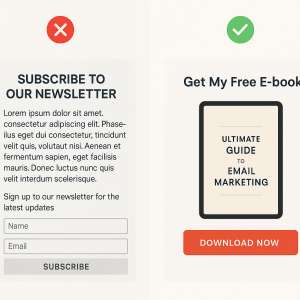
Getting Subscribers: Traffic Sources
Traffic is the fuel that powers your email list. You can have the best lead magnet and a perfectly designed opt-in page, but without people visiting it, your funnel stays empty. The good news? There are dozens of ways to drive traffic. The key is choosing the ones that fit your budget, time, and skill level.
Let’s explore the most effective options:
1. Free Traffic Sources (Time-Heavy, Cost-Free)
These methods don’t cost money, but they require consistency and effort.
-
Traffic Exchanges
A great starting point for beginners. You view other people’s sites to earn credits, which you then use to send visitors to your squeeze page. It’s a free way to start building a list if you don’t mind the clicks. -
Safelists
Similar to traffic exchanges, but email-based. You send emails to members of the safelist, and they send theirs to you. When used correctly, safelists can generate steady sign-ups. -
SEO Blogging
By writing keyword-optimized articles (like this cornerstone guide), you can attract organic traffic from Google. This is slower to build but long-lasting and highly targeted. -
Social Media Marketing
Platforms like Facebook groups, Twitter/X, LinkedIn, and YouTube allow you to share content and drive people back to your opt-in page.
👉 If you’re just starting, focus on traffic exchanges and safelists for quick wins, while building SEO and social presence for long-term growth.
2. Paid Traffic Sources (Fast, Scalable)
If you’re willing to invest money, you can scale your list faster.
-
Solo Ads
This is when you pay someone who already has a large email list in your niche to send your email to their subscribers. It’s one of the quickest ways to grow your list, though results depend on the seller’s quality. -
Co-op Advertising
Multiple marketers pool resources to buy traffic together, making it cheaper than solo buying. Great for testing without blowing your budget. -
Google & Facebook Ads
Paid ads allow for very specific targeting, but they require skill (and budget). Done right, they can bring in high-quality leads at scale. -
Native Ads & Banner Placements
Buying ad space on blogs, forums, or ad networks can be effective if your audience is niche-specific.
👉 Paid traffic is like turning on a faucet: you get results fast, but you need to budget carefully and track every click.
3. Mix and Match Strategy
The smartest approach is to use both free and paid traffic:
-
Free methods build consistency and a long-term base.
-
Paid methods accelerate growth when you’re ready to scale.
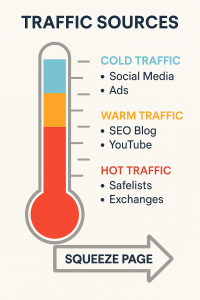
Email Sequences That Convert
Getting someone to join your list is only the first step. What you send next determines whether they stay engaged or disappear into “subscriber graveyard.” A strong email sequence builds trust, provides value, and sets the stage for sales.
Here’s how to structure it:
1. The Welcome Email (First Impression)
Your very first email sets the tone for the relationship. Make it warm, friendly, and immediately valuable.
-
Deliver the promised lead magnet right away.
-
Introduce yourself and your mission.
-
Set expectations for what kind of emails they’ll receive (tips, resources, special offers).
👉 Think of it like a handshake: brief, confident, and inviting.
2. The Nurture Sequence (Building Trust)
Over the next few emails, your goal isn’t to sell—it’s to educate and connect. Share tips, personal stories, or quick wins that help your subscribers see you as someone worth listening to.
-
Teach them something actionable.
-
Share a short success story or case study.
-
Ask a simple question to encourage replies (building engagement).
👉 Example: “Here’s how I got 50 subscribers from 300 safelist clicks—want me to show you the exact email I used?”
3. The Soft Promotion Emails
Once you’ve built rapport, it’s time to introduce helpful tools or offers. Keep it subtle at first.
-
Frame it as a recommendation, not a sales pitch.
-
Highlight how the product solves a problem they’ve already told you about.
-
Always include your affiliate links in a natural way.
👉 Example: “One of the tools that helped me improve my conversions is LeadsLeap. Here’s why I use it daily.”
4. The Hard Promotion Emails
At certain points, it’s okay to go stronger with promotions—especially when you’re running a special offer, launch, or time-sensitive deal.
-
Use urgency (limited time).
-
Add social proof (testimonials, case studies).
-
Send multiple reminders (some people only act on the last day).
👉 Think of this as the “closing” phase—but only after you’ve delivered real value first.
5. Frequency & Best Practices
-
Consistency beats bursts. It’s better to send 2–3 emails per week than disappear for a month and then send 5 in a row.
-
Segment your list. Send different emails to engaged vs. inactive subscribers.
-
Always test. Try different subject lines, formats, and calls-to-action to see what resonates.
👉 Rule of thumb: If your emails are valuable, subscribers won’t mind hearing from you often.
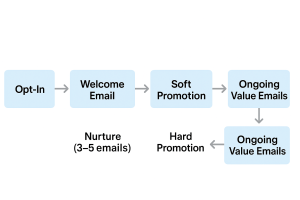
List Building Tools You’ll Need
You don’t need dozens of fancy tools to build your list—but you do need the right ones. With the right setup, your list building becomes smooth, automated, and scalable. Here are the key categories and some top options:
1. Autoresponders (Email Marketing Platforms)
An autoresponder is the backbone of your list-building strategy. It stores your subscribers’ information, delivers your lead magnets automatically, and manages all of your email campaigns.
Top choices:
-
LeadsLeap – Affordable, beginner-friendly, and packed with extra features (like page builder and tracking).
-
AWeber – One of the oldest and most reliable autoresponders; simple to use.
-
GetResponse – Great for advanced automation, webinars, and funnels.
-
ConvertKit – Popular with creators, bloggers, and coaches for its clean interface.
👉 Pro Tip: Choose a tool that fits your budget now, but can scale with you later.
2. Landing Page & Funnel Builders
Your opt-in page is where visitors turn into subscribers. A good page builder makes it easy to create high-converting squeeze pages—without needing a degree in web design.
Options to consider:
-
LeadsLeap (again!) – Includes a free drag-and-drop page builder inside its platform.
-
ClickFunnels – Powerful but more expensive; ideal for complete funnel systems.
-
Elementor (WordPress) – Flexible if you’re building pages directly on your site.
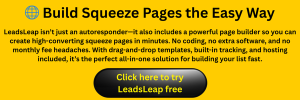
3. Tracking & Analytics Tools
Knowing where your traffic and conversions come from is crucial. Without tracking, you’re flying blind.
Recommended tools:
-
HitsConnect – Excellent for tracking safelist and traffic exchange campaigns.
-
Google Analytics – Free and powerful for website traffic insights.
-
UTM Links + Spreadsheets – Simple but effective if you’re just starting out.
👉 Tracking lets you double down on what works and cut what doesn’t.
4. Design & Content Tools
Presentation makes your lead magnets and emails feel professional. Thankfully, there are simple tools for non-designers.
Go-to options:
-
Canva – For lead magnet covers, infographics, and social graphics.
-
Designrr – Turn blog posts into formatted eBooks or PDFs fast.
-
Unsplash / Pexels – Free stock photos to improve your visuals.
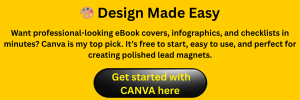
5. Productivity & Automation Helpers
The more you grow, the more time-saving tools matter.
-
Google Drive/Docs – Keep swipe files, templates, and email drafts organized.
-
Trello or Notion – Manage your content and email schedules.
-
Zapier – Connect tools together and automate tasks (like adding new subscribers to multiple lists).
Scaling Your List
Once you’ve got the basics down—lead magnet, opt-in page, autoresponder, and traffic—it’s time to move from “getting started” to “growing fast.” Scaling is about optimizing what’s already working and building systems that multiply your results.
Here are the core strategies to scale your list:
1. Split Test Everything
Small tweaks can mean big gains.
-
Headlines: Test curiosity vs. benefit-driven wording.
-
CTA Buttons: Try different colors and phrases (“Get Instant Access” vs. “Send Me the Guide”).
-
Opt-in Layouts: Compare simple vs. image-heavy designs.
👉 Pro Tip: Only test one change at a time so you know what’s making the difference.
2. Segment Your Subscribers
Not all subscribers are the same. By dividing your list into segments, you can send more relevant emails and improve conversions.
-
Segment by behavior (clickers vs. non-clickers).
-
Segment by source (solo ads vs. safelists vs. organic SEO).
-
Segment by interests (based on which lead magnet they signed up for).
👉 Example: If someone opts in for a “Safelist Tips Checklist,” they should get a different sequence than someone who grabs an “Affiliate Funnel Blueprint.”
3. Improve Deliverability
Scaling only matters if your emails land in inboxes—not spam folders.
-
Authenticate your domain (SPF, DKIM, DMARC).
-
Avoid spammy subject lines (ALL CAPS, too many !!!, etc.).
-
Keep your list clean—remove inactive subscribers every 60–90 days.
👉 The healthier your list, the better your sender reputation.
4. Create Multiple Funnels
Don’t rely on a single lead magnet or funnel. The fastest-growing marketers often have several entry points into their list.
-
Funnel #1: Safelist Traffic → Checklist Lead Magnet.
-
Funnel #2: SEO Blog Post → Case Study Lead Magnet.
-
Funnel #3: Paid Ads → Mini Video Training Lead Magnet.
👉 Each funnel feeds into the same list, but you’ll know which offers attract which kind of subscriber.
5. Scale Traffic Sources
When you’ve tested and tracked, it’s time to pour fuel on the fire.
-
Increase your ad spend on what’s converting.
-
Buy bigger solo ad packages from proven sellers.
-
Expand into new traffic exchanges and safelists.
-
Repurpose blog content into YouTube videos, podcasts, or infographics.
👉 Remember: don’t scale everything—scale only what’s already proven to work.
Common Mistakes to Avoid
Email list building is powerful, but it’s also easy to mess up if you don’t know the traps. Many beginners (and even seasoned marketers) make these mistakes that cost them subscribers, sales, and credibility. Learn to avoid them from the start:
1. Buying Low-Quality Lists
It may sound tempting—“10,000 subscribers for $50”—but purchased lists are almost always junk.
-
Most of those emails never asked to hear from you.
-
Sending to them can get you flagged as spam.
-
You risk harming your sender reputation permanently.
👉 Always build your list organically. Subscribers who choose to hear from you are worth 100x more than bought names.
2. Overselling Without Delivering Value
If every email you send is a sales pitch, subscribers will quickly tune out or unsubscribe.
-
Think “value first, offers second.”
-
Provide tips, tools, and insights before you ask for a click.
-
Follow the 80/20 rule: 80% value, 20% promotion.
👉 People stay on lists that make them smarter, not just lists that try to sell.
3. Ignoring Compliance Rules
Email marketing is regulated. Failing to follow the rules can get your account shut down or even lead to fines.
-
Always include an unsubscribe link.
-
Add your business address in the footer (CAN-SPAM requirement).
-
Be mindful of GDPR if you collect subscribers in Europe (clear consent, privacy policy).
👉 Compliance isn’t just about avoiding penalties—it also builds trust.
4. Not Testing or Tracking
Sending emails blindly is like throwing darts in the dark. Without tracking, you’ll never know what’s working.
-
Track which traffic sources produce the most opt-ins.
-
Split test subject lines to boost open rates.
-
Use click tracking to see which offers get attention.
👉 Data-driven decisions = faster growth and higher profits.
5. Neglecting List Hygiene
An email list is like a garden—it needs upkeep. If you never prune it, weeds take over.
-
Remove subscribers who haven’t opened in 60–90 days.
-
Re-engage inactive subscribers with a special “win-back” sequence.
-
Keep an eye on bounce rates (too many bad emails hurt your reputation).
👉 A smaller, engaged list is far more valuable than a huge, dead one.
Advanced Strategies
Once you’ve built a solid foundation—consistent traffic, strong opt-ins, and an engaged list—it’s time to unlock the next level of growth and monetization. These advanced strategies help you maximize conversions, increase revenue per subscriber, and build long-term authority in your niche.
1. Monetize with Tripwire Funnels
A tripwire funnel is a small, low-cost offer ($5–$27) you present immediately after someone joins your list.
-
Purpose: Turn new subscribers into buyers right away.
-
Example: “Affiliate Funnel Quick Start Guide — Only $7 Today.”
-
Benefit: Buyers are much more valuable than freebie seekers because they’ve proven they’ll spend money.
👉 Even a small first sale dramatically increases lifetime value.
2. Deep Segmentation & Personalization
Basic segmentation divides subscribers into broad groups, but advanced segmentation tailors messages based on behavior.
-
Send different sequences to people who clicked a link vs. those who didn’t.
-
Offer different products to subscribers based on which lead magnet they signed up for.
-
Personalize subject lines with names, locations, or behaviors.
👉 The more relevant your emails feel, the higher your open and conversion rates.
3. Launch Your Own Digital Products
Instead of promoting only affiliate offers, consider creating your own small product.
-
Ideas: Templates, checklists, swipe files, short courses.
-
Benefits: Higher profit margins, instant authority, and new affiliate opportunities (others can promote your product).
-
Pair it with your list: Announce launches directly to engaged subscribers.
👉 Owning a product means you’re not just an affiliate—you’re a brand.
4. Use Co-op Advertising Pools
Co-op traffic pools let multiple marketers combine resources to buy higher-volume traffic at a lower cost.
-
Great for safelists, solo ads, and banner placements.
-
Reduces risk because costs are shared.
-
Works best when paired with tracking to measure ROI.
👉 Co-ops are especially effective for scaling without breaking the bank.
5. Leverage AI for Optimization
Artificial Intelligence can make your campaigns sharper and faster.
-
Use AI tools to generate subject lines and test variations.
-
Automate segmentation with predictive analytics.
-
Create dynamic content that changes based on subscriber behavior.
👉 AI won’t replace your strategy, but it can give you an edge over competitors who still rely on guesswork.


